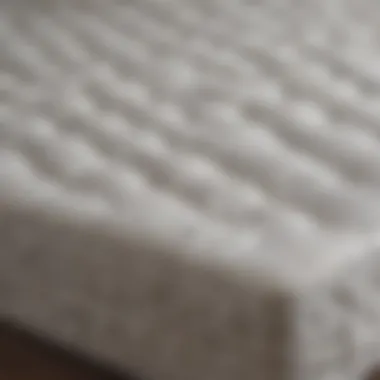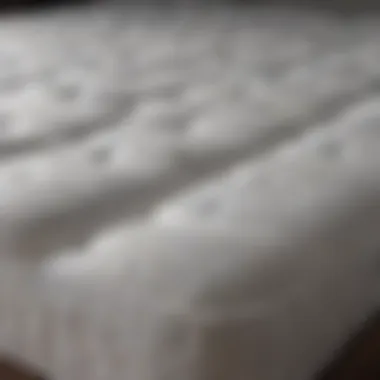Best Mattress Pad for Pressure Point Relief


Intro
In today's fast-paced world, achieving restful sleep is increasingly essential, yet many struggle with discomfort during the night. A key contributing factor to poor sleep quality is pressure points arising from inadequate support. This article dives into how a quality mattress pad can alleviate such issues, enhancing overall sleep experiences. Understanding materials, construction, and the features of mattress pads is vital for making an informed decision that caters to individual preferences.
This guide aims to elucidate these aspects, guiding homeowners and sleep enthusiasts alike toward the best options available.
Key Considerations for Selecting a Mattress Pad
When exploring the best mattress pads for pressure points, certain features should be at the forefront of your decision-making process.
- Material Composition: Mattress pads come in varied materials, from memory foam to cotton. Each offers distinct benefits, especially concerning pressure relief.
- Thickness: The thickness of a pad can directly impact comfort levels. Thicker pads may provide additional cushioning, ideal for those who experience discomfort.
- Breathability: Materials that promote airflow help keep the mattress cool, contributing to a more comfortable night's sleep.
- Washability: A removable and washable cover simplifies maintenance, beneficial for hygiene and longevity.
Comparing Material Options
Each material type has its specific advantages tailored to different preferences:
- Memory Foam: Known for its contouring properties, memory foam evenly distributes weight, effectively reducing pressure on sensitive areas.
- Latex: Solid support and responsiveness characterize latex. Its natural elasticity makes it a popular choice for those who prefer a bouncier feel.
- Feather and Down: Renowned for plush comfort, these materials offer softness but may lack support for some individuals.
- Cooling Gel: Incorporating gel technology in memory foam can enhance breathability and temperature regulation, relieving discomfort stemming from heat retention.
"Selecting the right mattress pad involves understanding your specific sleep needs and preferences, ensuring that comfort is paramount."
Finale
With the right mattress pad, the journey toward restful sleep becomes significantly more achievable.
Understanding Pressure Points
Understanding pressure points is essential for anyone seeking better sleep quality and overall well-being. Pressure points refer to specific areas on the body that experience increased pressure due to contact with a surface, typically during sleep. These points can lead to discomfort, pain, and even disrupted sleep cycles. Recognizing how these areas react to different sleeping surfaces can significantly impact one's comfort and health.
Investing time in understanding pressure points allows individuals to choose a mattress pad that alleviates discomfort and supports proper alignment. This knowledge is vital as it directly influences how restful and restorative one's sleep is. A good mattress pad can act as a buffer, distributing weight evenly and reducing the risk of developing sore spots.
What Are Pressure Points?
Pressure points are localized areas of the body that feel significant discomfort or pain when subjected to pressure. When lying down, certain body parts, such as the shoulders, hips, and lower back, can bear the brunt of weight, leading to pressure buildup. These pressure points can restrict blood flow, causing tingling sensations or discomfort. As a result, individuals may change positions frequently, which interrupts sleep continuity.
How Pressure Points Affect Sleep Quality
The state of pressure points greatly impacts the quality of sleep. When a person lies down and pressure builds up in certain areas, it can lead to restlessness. Difficulty in maintaining a comfortable position during sleep can result in an increase in sleep disturbances. Tension in the body may also rise as pressure builds, which can lead to muscle tightness. All these factors culminate in a frustrating cycle that reduces sleep quality and next-day alertness.
Common Areas of Pressure Points
There are several common areas where pressure points often develop during sleep:
- Shoulders: This area can often feel pressure from the weight of the head and upper body, causing discomfort.
- Hips: For side sleepers, hips may take on significant pressure, leading to pain.
- Lower back: Poor support can lead to lower back strain, especially for those who sleep on their back or stomach.
- Knees and ankles: Depending on sleeping position, these areas can also bear weight and pressure.


Each of these pressure points can lead to various sleep issues if not properly addressed. Therefore, understanding their implications is crucial for selecting the right mattress pad that offers adequate support and comfort.
The Role of Mattress Pads
Mattress pads play a crucial role in providing comfort and support during sleep. They serve as an extra layer between the sleeper and the mattress, thus influencing the overall sleep experience. By alleviating pressure points, they are essential for those who experience discomfort when lying down for extended periods. This section will explore why investing in a quality mattress pad is beneficial, along with the different types available that cater to varying needs.
Why Use a Mattress Pad?
Using a mattress pad can enhance sleep quality. It adds softness or firmness based on individual preferences and needs. Furthermore, mattress pads can prolong the life of a mattress by protecting it from wear and spills. They are easy to remove and clean, which adds convenience. For many, a mattress pad can significantly improve comfort and support in their sleeping environment.
Types of Mattress Pads
When it comes to mattress pads, there are several types, each catering to different comfort levels and pressure point relief. Let’s discuss the specific characteristics and advantages of each type:
Memory Foam Mattress Pads
Memory foam mattress pads are known for their ability to conform to the body’s shape. This characteristic reduces pressure on sensitive areas like hips and shoulders. Many choose memory foam for its luxurious feel and support. The unique ability to distribute weight evenly is a significant advantage of memory foam. However, some might find it retains heat, which can be uncomfortable in warmer climates.
Latex Mattress Pads
Latex mattress pads are often chosen for their durability and responsiveness. They offer a bouncy feel and are excellent at providing support while maintaining a cooler sleeping surface. Natural latex is hypoallergenic and resistant to dust mites. While it is a beneficial option for many, it can be pricier compared to other materials.
Polyester Mattress Pads
Polyester mattress pads are generally the most affordable option. They are lightweight and easy to clean. However, they may not provide the same level of support as memory foam or latex. These pads are easy to find and can suit various needs, but they often lack durability compared to other materials.
Wool Mattress Pads
Wool mattress pads are appreciated for their natural insulating properties. They can keep you warm in winter and cool in summer. This material is breathable, which helps maintain a comfortable temperature during sleep. Although they are more expensive, their natural resilience and ability to wick away moisture make them a worthwhile consideration for long-term use.
Key Features to Consider
In selecting the right mattress pad to alleviate pressure points, several vital features should be considered. These features directly correlate with both comfort and support, which are essential for a good night's sleep. The right mattress pad can significantly influence how well you rest and how refreshed you feel in the morning. Thus, understanding these aspects is crucial.
Thickness and Density
Thickness contributes significantly to how well a mattress pad cushions pressure points. A thicker pad generally provides more cushioning and can distribute body weight more evenly. This is particularly important for those who experience discomfort at specific areas when lying down for extended periods. However, thickness is not the only consideration; density also plays a role. High-density pads may offer better support and durability compared to lower densities, preventing sagging over time. The combination of thickness and density should align with the sleeper’s preference for firmness or softness to achieve optimal comfort.
Material Composition
The materials used in mattress pads can greatly impact their performance and durability. Each material comes with unique properties that affect comfort, heat retention, and responsiveness. For instance, memory foam mattress pads are known for their body-conforming capabilities, providing excellent pressure relief. On the other hand, gel-infused foam enhances breathability, preventing heat buildup. When choosing a mattress pad, consider whether it utilizes materials like memory foam, latex, polyester, or wool. Your choice of material should also correspond with any specific allergies or sensitivities you may have.
Cooling Properties


As sleep quality can decline due to overheating, the cooling properties of a mattress pad are important. Pads that incorporate cooling technologies can help regulate body temperature during sleep. Options like gel-infused memory foam or breathable fabrics promote airflow and wick away moisture. These features can significantly enhance comfort, especially for individuals who tend to sleep hot. Look for mattress pads that explicitly describe their cooling capabilities to ensure a more restful sleep experience.
Hypoallergenic Features
For many individuals, allergens can disrupt sleep. Mattress pads with hypoallergenic properties can mitigate this issue, providing relief from dust mites, mold, and other allergens. Fabrics treated to repel allergens are beneficial for sensitive sleepers or those with respiratory issues. When selecting a mattress pad, check for features like allergen-proof covers or materials known for their resistive properties. This consideration can lead to healthier sleep conditions, contributing to overall well-being.
Considering these key features helps in making an informed choice when selecting a mattress pad. A thoughtful evaluation of thickness, material, cooling properties, and hypoallergenic features can dramatically enhance sleep quality.
Top Mattress Pads for Pressure Relief
In the realm of sleep quality, the importance of selecting the right mattress pad cannot be overstated. A good mattress pad serves as a supportive layer between the body and the mattress, helping to alleviate pressure on the body's sensitive areas. This is especially crucial for individuals who experience discomfort during sleep due to pressure points. These areas, often found in the back, hips, and shoulders, can lead to disrupted sleep patterns and overall fatigue. Therefore, focusing on mattress pads specifically designed for pressure relief is essential for anyone seeking a better night’s sleep.
When exploring the best mattress pads for pressure relief, several specific considerations come into play. Each material type offers unique benefits, catering to varied preferences and needs. Some people may prefer the cushioning support of memory foam, while others might lean towards the responsiveness of latex. Understanding these distinctions aids consumers in making informed decisions that promote both comfort and health during sleep.
Best Memory Foam Mattress Pads
Memory foam mattress pads are well-known for their contouring capabilities. They respond to body heat and weight, allowing them to mold to the shape of the sleeper. This property offers excellent support to pressure points, distributing weight evenly and thereby reducing the likelihood of discomfort. When choosing a memory foam pad, it's important to consider its density. A higher density foam typically provides better support and durability. Look for products that offer cooling features as well, since memory foam can retain heat, which may disrupt sleep for some individuals.
Best Latex Mattress Pads
Latex mattress pads are another excellent option for pressure relief. Unlike memory foam, latex responds more readily to movements, making it easier to change positions during sleep. The natural elasticity of latex allows it to provide firm support while also accommodating the body's contours. Additionally, latex pads typically offer better breathability and cooling compared to memory foam. Consider organic latex options for those seeking eco-friendly products. Overall, latex mattress pads provide a balanced mix of support and comfort.
Best Eco-Friendly Options
For environmentally conscious consumers, eco-friendly mattress pads are gaining popularity. These pads are often made from sustainable materials, such as organic cotton, bamboo, or natural latex. Choosing eco-friendly options not only benefits the environment but can also result in healthier sleeping conditions, free from harmful chemicals and toxins. Many manufacturers now provide certifications proving their products meet stringent ecological standards. This category is worth exploring for those prioritizing sustainability without compromising on comfort.
Best Budget-Friendly Choices
Finding a quality mattress pad that fits within a budget is possible without sacrificing comfort. There are numerous options available that offer essential pressure relief features without an excessive cost. Look for brands that utilize foam or fiber blends. These often provide a good balance of comfort and support while being easier on the wallet. It is crucial, however, to ensure that even budget picks maintain a certain level of quality to guarantee a satisfactory sleeping experience.
Consumer Considerations
When selecting a mattress pad intended for mitigating pressure points, it is essential to thoroughly consider various consumer factors. These considerations can significantly affect both the performance of the mattress pad and the overall sleep experience. Understanding individual needs and evaluating return policies can guide consumers toward a satisfactory purchase.
Identifying Individual Needs
Each individual has unique sleeping preferences and needs. These variations stem from factors like body weight, sleeping position, and personal comfort levels. For instance, side sleepers may require more cushioning to alleviate pressure on the hips and shoulders. Meanwhile, back sleepers might benefit from a firmer mattress pad that offers spine support without compromising comfort.
Here are some crucial factors to keep in mind when identifying individual needs:
- Weight Considerations: Lighter individuals might prefer softer materials, while heavier individuals may need denser options to prevent sinking too deeply.
- Sleeping Position: Side sleepers need more soft support to reduce pressure, whereas stomach sleepers may opt for a firmer feel.
- Material Preferences: Some may gravitate towards natural materials, while others might favor synthetic options for their durability or specific features, like cooling properties or hypoallergenic characteristics.
By assessing these elements, consumers can better match their sleeping habits to a suitable mattress pad, ensuring a more restful night's sleep.


Evaluating Return Policies
A mattress pad's return policy is a critical consumer consideration. Given the personal nature of comfort, it is common that a mattress pad may feel different once used, compared to its initial impression in a store or during a short trial. Therefore, understanding the return policies can provide peace of mind.
Key aspects to look for in return policies include:
- Trial Period: Some brands offer a trial period, allowing customers to test the product for a specific duration before committing.
- Return Window: Check how long after purchase a return can be initiated. A longer window may be beneficial for assessing long-term comfort.
- Conditions for Returns: Knowing whether a product must be unused or in original packaging helps avoid assumptions and ensures compliance.
Evaluating return policies ensures that consumers have options if the mattress pad does not meet their comfort expectations.
"Understanding your individual needs and the return policies can lead not just to a better purchase, but also a more profound sleep experience."
By carefully analyzing these considerations, consumers can navigate their way through the complexities of buying the best mattress pad to address pressure points. Such preparation is paramount for ensuring satisfaction after the purchase.
Maintaining Your Mattress Pad
Maintaining your mattress pad is crucial for preserving its protective function against pressure points. A well-maintained mattress pad supports better sleep quality and overall comfort. With the right care, a mattress pad can last longer and continue to provide the necessary support. This section explores essential cleaning guidelines and longevity tips to keep your mattress pad in optimal condition.
Cleaning Guidelines
Regular cleaning is vital to eliminate allergens and dust mites that can accumulate in your mattress pad. Here are some guidelines:
- Frequency: Aim to wash your mattress pad every one to three months, depending on usage and any allergies.
- Check Labels: Always read the manufacturer’s instructions before cleaning. Different materials might require specific care.
- Machine Wash: Most mattress pads are machine washable. Use a gentle cycle with cold water. For memory foam or latex pads, hand wash if the label advises.
- Detergent: Use a mild detergent without bleach. Harsh chemicals can degrade the materials over time.
- Drying: Air dry is preferable, but if using a dryer, select a low heat setting to avoid damage. Avoid fabric softeners, as they can leave a residue that makes the pad less breathable.
Longevity Tips
To maximize the lifespan of your mattress pad, consider the following tips:
- Use a Protector: Place a mattress protector under your pad. This adds another layer of defense against spills and stains.
- Rotate Regularly: If applicable, rotate or flip your mattress and pad every few months. This prevents uneven wear.
- Avoid Heavy Loads: Refrain from sitting on the edge of your bed excessively. This can compress the materials and reduce their effectiveness.
- Store Properly: If you need to store your mattress pad, fold it neatly and keep it in a cool, dry place. Avoid putting heavy items on top of it.
"Taking care of your mattress pad not only enhances its lifespan but also ensures you maintain optimal sleeping conditions."
Culmination
In the realm of sleep quality, pressure points play a crucial role in determining overall comfort. The concludsion of this article reinforces the significance of selecting the right mattress pad to address these specific needs. A suitable mattress pad can reduce pain and discomfort when sleeping, allowing for deeper, more restorative rest.
A well-chosen mattress pad offers more than just cushioning. It can enhance spinal alignment, support body weight, and promote proper circulation. When these factors are addressed, sleep becomes not just a routine but a rejuvenating experience. Homeowners and design enthusiasts seeking to create a tranquil sleeping environment should pay attention to the material, thickness, and density of mattress pads.
Benefits and Considerations
Here we summarize the key benefits of selecting the right mattress pad:
- Pressure Relief: A good mattress pad helps distribute body weight evenly, reducing stress on sensitive areas.
- Temperature Regulation: Some materials are better at managing heat, ensuring a comfortable sleep temperature.
- Durability: Quality mattress pads last longer, providing years of comfort and support.
As consumers, it is vital to evaluate individual needs, whether you prefer memory foam’s conforming support or the bounce of latex. Also, considering hypoallergenic features can be crucial for those with allergies.
To conclude, as you explore the vast options available, remember that the right mattress pad can be an investment in both health and comfort. You are not just buying bedding; you are upgrading your sleep quality.
"The right mattress pad can lead to significant benefits, enhancing the entire sleep experience."
Ultimately, maintaining awareness of the specific elements discussed will empower individuals to make informed choices, enabling restful nights and potent daytime productivity.















